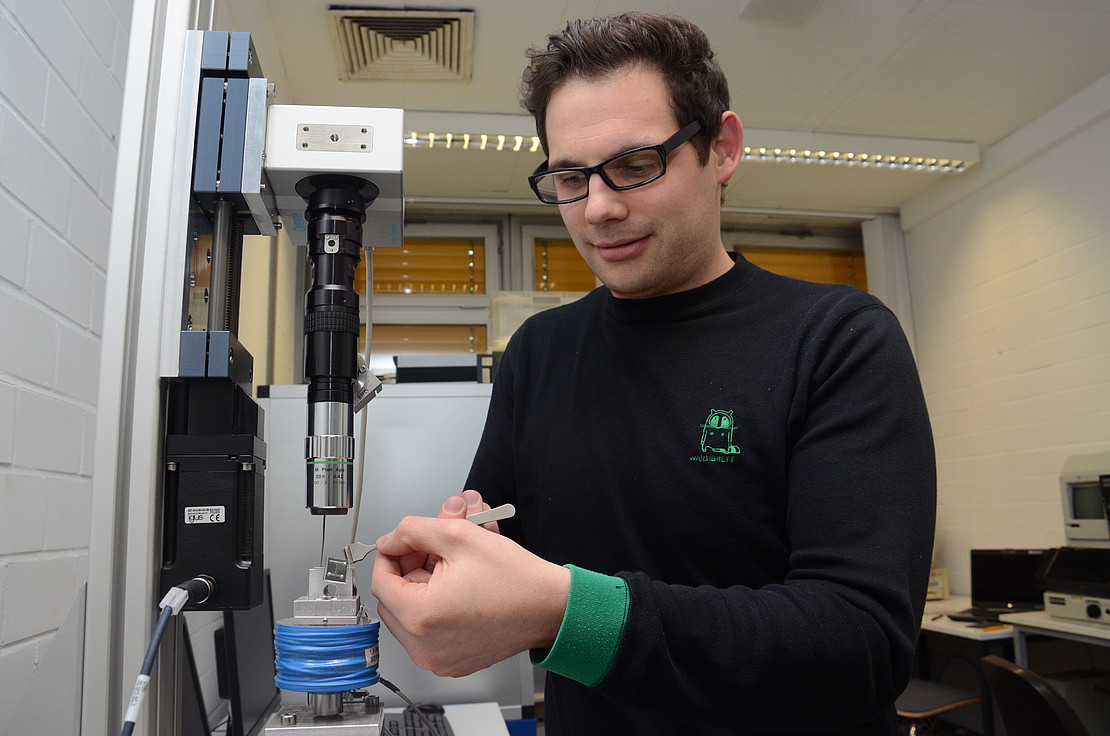This page contains automatically translated content.
Tiny sensor could quickly detect and monitor cancer - prototype planned
 Image: Dilling | University of Kassel
Image: Dilling | University of KasselBiomarkers play a major role in the detection of cancer. These are biomolecules that indicate the presence of a malignant tumor if they are present in a certain quantity. These include, for example, HER2, which can indicate certain types of breast cancer, and the surface protein EpCAM, which is more prevalent in epithelial cell tumors. Today, these molecules can already be detected with the help of antibodies. But this is time-consuming and costly. The samples are analyzed in large laboratories.
The development from Kassel is intended to simplify a lot of this. The scientists want to place their innovative technology platform on a battery-powered diagnostic chip just two centimeters in size, which could be operated on an outpatient basis and even by the patient himself. That's still a long way off. But within three years, a prototype could be built using the results of this basic research, estimates Prof. Dr. Arno Ehresmann from the Institute of Physics at the University of Kassel. He is collaborating on the development of the sensor system with Prof. Dr. Friedrich Herberg from the Institute of Biology/Biochemistry and biochemist Prof. Dr. Andreas Plückthun from the University of Zurich. Once the sensor is ready for the market, a surgeon, for example, could examine whether he has removed all tumor tissue during a cancer operation, explains Prof. Ehresmann.
Together, the three scientists developed the basic principles for the three components of the invention: Prof. Plückthun "builds" customized capture molecules in the laboratory, so-called DARPins, special, robust proteins that are able to bind cancer biomarkers particularly tightly to themselves. Prof. Herberg is responsible for the complex chemistry involved in attaching the capture molecules to magnetic particles. Prof. Ehresmann developed the transport system that ensures that sufficient analyte-ready material is transported from the body fluid under investigation to the sensor. Magnetized polymer particles 0.5 to 2 micrometers in size, in which magnetic iron oxide grains are embedded, are moved and controlled by an alternating magnetic field. They serve as vehicles for the capture molecules to which the biomarkers have docked on their way to the sensor.
This transport process was the particular challenge for the scientist. This is because the biomarkers to be detected are not distributed evenly in the blood, but rather randomly. In addition, a large number of other proteins and molecules cause "background noise" during the analysis process that obscures the signal of the biomarkers being sought. Furthermore, magnetic particles clump together because they attract each other. Ehresmann has solved all three problems. He uses so-called superparamagnetism to control the changing magnetic orientation of these particles and prevent them from clumping. The moving particles create turbulence in the fluid being analyzed, making it easier for biomarkers to dock with the capture molecules. Horizontally stacked, thin layers of partially magnetized nanomaterial provide a magnetic force field that uniformly directs the molecule-particle assemblies under investigation to the sensor surface, as in a convoy. During this "journey", they travel through several parallel strip-shaped liquid channels in which components that could falsify the analysis are gradually washed out of the liquid, so to speak.
A large investment is still needed to build a prototype. Ehresmann and his colleagues are currently investigating whether it would be suitable to set up a spin-off company to market the sensor, or whether a medium-sized company could turn this promising technology into a product. Ehresmann is also interested in further collaborations with physicians so that the versatile technology can be differentiated in a targeted manner. The researchers have also applied with their project for funding from the European research program "Personalising health and care" (PHC10), which aims to develop new diagnostic methods and devices.
Image (Photo: Dilling/University of Kassel) at:
www.uni-kassel.de/uni/fileadmin/datas/uni/presse/anhaenge/2014/017.JPG
Caption: Graduate nanoscientist Dennis Holzinger prepares an experiment with the novel analysis chip. He places it on the carrier of an electromagnet, which sets up the magnetic force field to control the liquid to be analyzed on the chip. Using a microscope (center), Holzinger can observe the progress of the experiment.
Image by Prof. Dr. Arno Ehresmann (Photo: University of Kassel) at:
www.uni-kassel.de/uni/fileadmin/datas/uni/presse/anhaenge/2014/Universitaet_Kassel_ELCH_2012-09-10_66088469.jpg
Contact:
Prof. Dr. Arno Ehresmann
University of Kassel
Department of Thin Films and Synchrotron Radiation
Tel: +49 561 804-4061
E-mail: ehresmann[at]physik.uni-kassel[dot]de